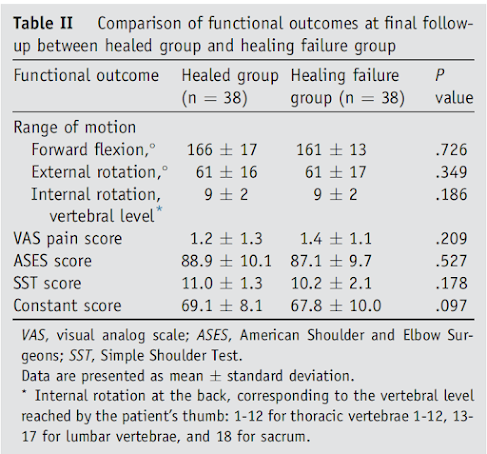These authors point out that a decreased acromiohumeral distance (AHD) is commonly detected in patients with massive rotator cuff tears (mRCTs). They aimed to evaluate the predictive role of the preoperative AHD measured using stress radiography (AHD_stress) in rotator cuff healing and function after arthroscopic repair of mRCTs in 113 patients.
Postoperative cuff integrity was evaluated using magnetic resonance imaging at 1 year, and shoulder function was evaluated at a mean of 35 months postoperatively.
Forty-seven patients (42%) failed to heal the repair.
The preoperative AHD and AHD_stress were defined as the shortest distances from the inferior acromion to the superior humerus on standard anteroposterior radiography and stress radiography (5.4-kg weight applied inferiorly in a neutral position), respectively. The AHD difference (AHD_diff) was defined as the difference between the AHD and AHD_stress values.
The preoperative AHD_diff value was significantly higher in the healed group (4.4 mm) than in the healing failure group (3.0 mm).
Patients with a preoperative AHD_diff value ≥ 3.2 mm showed a lower healing failure rate (28.9% vs. 71.1%) and higher functional scores than patients with an AHD_diff value < 3.2 mm.
The preoperative AHD_diff value was higher in patients with an American Shoulder and Elbow Surgeons (ASES) score ≥ 80 (4.9 mm) than in those with an ASES score < 80 (3.1).
The patients' outcome scores were essentially the same for failed repairs and healed repairs.
Comment: These authors suggest that a preoperative AHD that increased by 3.2 mm under stress radiography could be defined as a reducible AHD. and that a reducible AHD obtained from preoperative stress radiography can be used in predicting cuff healing and function in patients with mRCTs.
Patients with a reducible AHD had healing failure rates of 28.9% while those without reducible AHD had healing failure rates of 71.1%. They suggest that in cases with fixed humeral head elevation, it may be difficult to re-center the humeral head in the glenoid.
Basically they are using preoperative stress views to identify shoulders in which the humeral head is "stuck up" - i.e. inferior traction cannot restore the normal register of the humeral head in the glenoid. In these stuck up shoulders, cuff repair is much more likely to fail.
The other important finding in this study is that the success of cuff repair (i.e. healing by MRI) did not affect the clinical outcomes, either with respect to range of motion or patient reported outcome. This finding is consistent with many other studies demonstrating a lack of correlation between cuff healing and functional improvement realized by the patient. So the interesting question is, "why did the patients with failed repairs get better?"
How you can support research in shoulder surgery Click on this link.


